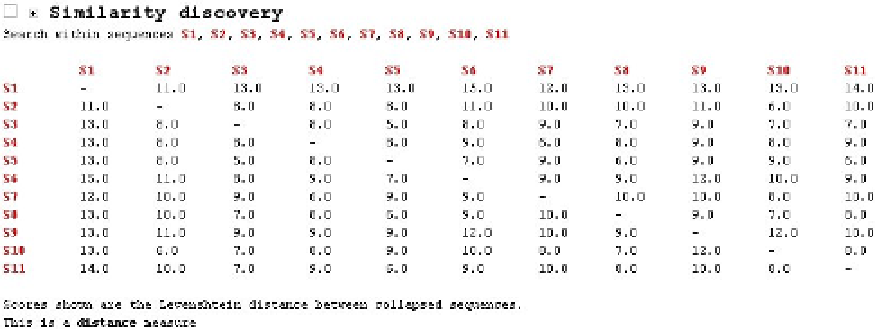Geography Reference
In-Depth Information
method is the transformation of two-dimensional data (X, Y coordinates of fixations) to one-
dimensional data (character string). Each ScanPath is recorded as a string of letters where
each letter corresponds to the area of a current fixation location.
Two or more character strings are then compared and their similarity is measured. Defined
by an optimization algorithm, string editing assigns a unit value to three different character
operations: deletion, insertion, and substitution. Characters are then manipulated in order to
transform one string into another and character manipulation values are tabulated [41].
String edit algorithm determines the number of operations needed to transform one
sequence to another - the operations being insertions, deletions and substitutions. The
calculated metric will be a measure of how different two sequences are. This method uses
the Levenshtein algorithm to produce a string-edit distance between each sequence [42].
Example of the Levenshtein distance measure is in the figure 4. Character string comparison
methods are widely used in bioinformatics to align DNA and protein sequences.
Figure 4.
Result of the Levenshtein distance measure between group of eleven geoinformatics while
observing a map. Gridded AOI with grid of 5*5 cells was used
Depending on specific tasks, it is important to distinguish between gridded AOI and semantic
AOI approaches. When using the Gridded AOI, stimulus is split into areas of equal size
(rectangles) with no relation to semantics. The second approach, Semantic AOI uses the Area of
Interest which corresponds to specific areas in stimuli. In cartography, Semantic AOI is generally
more advantageous because it corresponds to map composition elements like title, legend, etc.
4.3. Attention maps
Attention maps, also called HeatMaps, are used for visualization of quantitative
characteristics of the user's gaze. Thanks to attention maps, it is possible to identify to which
area user pay attention and which are rather neglected. In eye-tracking, HeatMaps enable
the creation of a brief summary of areas which are in the spotlight and so they are needed to
be analyzed more thoroughly. Except of the function of visualization, they might be used as
a background for AOI creation. When plotting AOI around a small object, fixations of some
of the respondents could be noted outside the created AOI because of inaccurate

